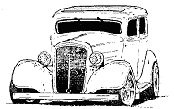Flames, Scalames & Hot Licks
The Art of Hot Rod Graphics
By Rich Boyd
Photography: Rich Boyd, Thaxton Press, The Primedia Digital Staff
While some might say, “Real hot rods are red and have no fenders,” there’s a considerable contingent of hot rodders who believe that “Real hot rods are powerfully propelled and have flames abundantly displayed on their hoods and fenders.” As a growing number of enthusiasts have turned their attention to the traditions that describe our hobby, the subject of flames has never burned brighter. Plus, there has never been a greater profusion of (or reverence for) this graphic automotive art.
R&C first featured Rod Powell’s flame art on the cover of the August ’68 issue, where it graced the exterior of Richard Bass’ ’40 Ford. We also highlighted the “Pyro-Technique Artists: AKA Famous Flamers,” in Rod & Custom April ’98. Regrettably, we had no color pages available to display this very colorful subject. So the July ’98 issue was dedicated to “Hot ’N’ Flamin’” rides—readers were treated to a history lesson from Thom Taylor on the origin of flames, which took a look at some work from the most talented West Coast painters of the ’50s. More recently, R&C presented “Flame Tips From the Pros” (May ’01), showing a step-by-step how-to approach by Dennis Ricklefs.
We continue to fan the flames this month with a look at some of the flame jobs that have been captured in our viewfinders during the past several years. We also expose more of the graphic guys who light ’em on fire! There are very few gearheads who haven’t rendered some fiery drawings in the margins of their notebooks or imagined how their ride would look with a fabulous set of flames crawling over the hood and fenders. Today, flames appear on almost anything that can be painted with one-shot—trash cans, refrigerator doors, and even a giant sailfish or two. And the description of torch graphics is a language of its own. There are Trad (traditional) flames, Tribal flames, Seaweed flames, Interlocking and Overlapping flames, the Ohio Look, and Ricklefs’ Licks. Dedicated flame lovers can recognize favorite pyrotechnic artists by their individual styles. Check out these images of scorched rides that blaze a trail to our collective hot rod consciousness.
|
|
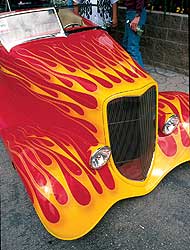
|
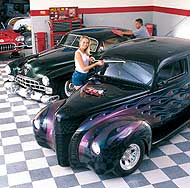
Traditional flame treatments employ a white base with yellow toner as the primary color. However, as paint technologies change, techniques are also changing. A recent trend is the use of iridescent color-changing paints on a black base, allowing for a dramatic impact. On the cover of R&C April 2000, Chris and Kathy Wills ’40 Ford sedan with Art Himsl flames was a visual standout.
|
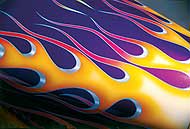
Another Art Himsl innovation is the use of a design element that appears three-dimensional due to the highlights, seen here on Andy “The Rodfather” Brizio’s purple Deuce highboy. Art used a silver or neutral color originally so as not to compete with the flame colors. He’s now experimenting with complementary colors for even greater visual impact.
|

Here’s a close-up of the seaweed flames that cover the hood of Sammy Head’s ’61 Ford F-150. Redondo Joe Railey laid these intricate bright-green flames over a satin gray-green primer. This truck was featured in Sport Truck magazine in the July ’01 issue.
|
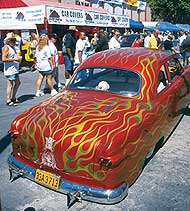
Steve Sellers’ copper-with-green-flames custom shoebox has an ultra wild set of seaweed flames in the Larry Watson tradition. Notice that they’re on top of traditional pinstripes.
|

Another unusual set of triple-layer over-and-under flames is found on this purple ’32 Ford highboy coupe, owned by Floyd Bowman of Bakersfield, California. The pyro- technic artist was Slim at Kelleys’ Kustom Rods & Rides in Bakersfield, California.
|
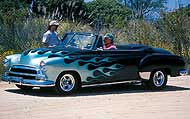
Bob Cagle’s ’51 Chevy (featured in R&C February ’99) has some Lil’ Louie hot licks that are silver edged in a pastel teal. These flames are fairly symmetrical on both sides though the flame licks work their way around the hood louvers.
|
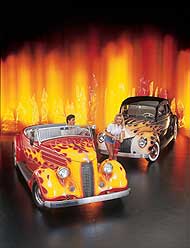
Jimmy Gacchina’s ’36 Ford roadster and Chuck Keranen’s ’40 Ford coupe were goin’ up in flames on the cover of R&C for July ’98. Tom “Itchy” Otis executed the traditional licks over a white base, then added traditional pinstripes to the fenders of Keranen’s coupe. This issue included a piece on the origin of flames by designer Thom Taylor that includes early photos of the Von Dutch–torched Earl Bruce gullwing Mercedes. Other photos show early Larry Watson seaweed licks and Dean Jefferies crab-claw flames on his own Mercury convertible.
|
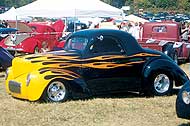
Jim Lambert’s ’41 Willys coupe from Cincinnati, Ohio, has a unique set of thin and extended double flicks racing down the body side, known as Ohio Flames. Notice the green tips of the flame licks.
|
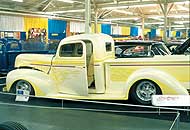
Here’s a very sophisticated design on the yellow ’40 pickup owned by Sue Alonzo of Walnut Creek, California. Art Himsl painted the fabulous hot rod truck and designed the Tribal flames that have little hooks and notches in the flame shapes. If you look closely you can also see a shadow flame in light gray floating in the background on the door.
|

Most flamed graphics have a relaxed, free-flowing design, but the lightning-bolt flames on Bill and Cherrill Dunn’s yellow Willys have a less relaxed and even a highly excited look, and were designed and painted by Rob Ida of Ida Automotive.
|

Here are two Toms—Tommy the Greek and Tom “Itchy” Otis sit in Otis’ traditional black with flames Deuce highboy. Note the way the flames are contained by a pinstriped edge around the front of the grille and the painted louvers. The Toms think flames shouldn’t make the rod look like a two-tone paint job.
|
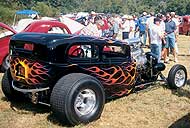
Rod Powell gave this black ’32 Tudor sedan the full flame treatment back when it belonged to John Schipp. “There are flames everywhere except on the grille shell—it was too short to work the design on comfortably!” says Powell. The car is now owned by Jim Durham of Cairo, Georgia. The license plate reads HELL ROD.
|
|



